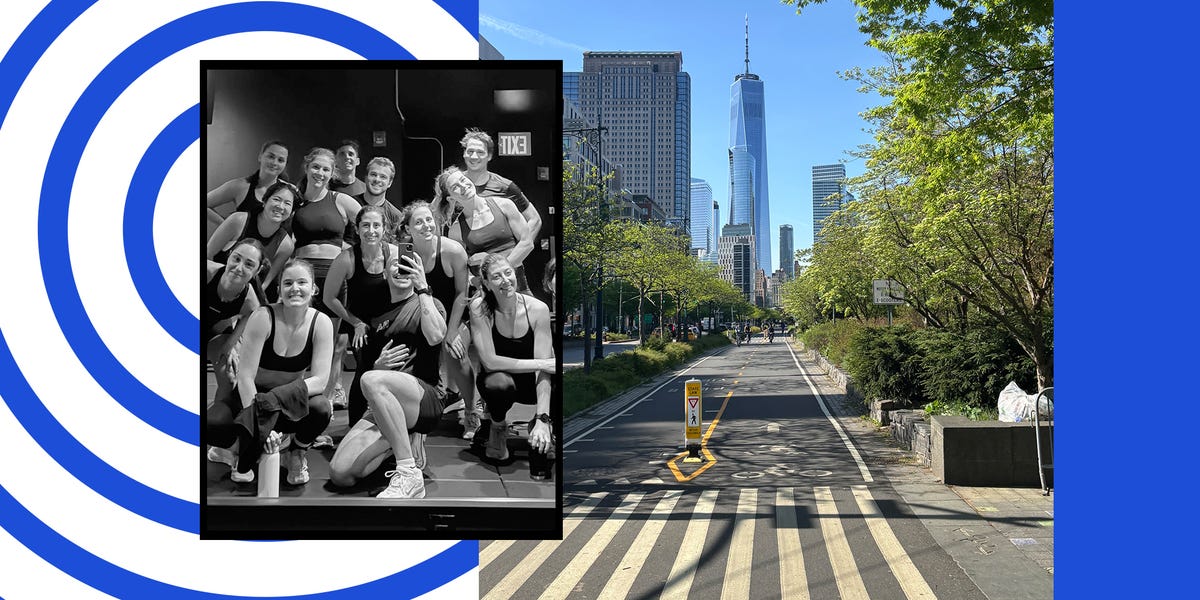Try as I might, I’ve never been a member of the early-bird gang. A more accurate label? Intermittent, noncommitted subscriber.
Though I spent most of my teenage years and early adulthood in competitive sports, I was not among that ilk of athletes who woke up at 5 A.M. for optional lifts or runs, whether by choice or coach-imposed force. In high school, cross-country and track practice thankfully happened in the afternoon. When I ran competitively in college, I was thrilled to learn most practices were scheduled between late morning and mid-afternoon.
So, after I transitioned into the 9-to-5 life, evening workouts naturally became the norm. Rather than wrenching myself out of REM sleep, I preferred to move when I felt more relaxed and energized at the end of the day. As a certified night owl who also has Lyme disease—and therefore struggles with bouts of intense fatigue—waking up early has always been an uphill battle.
But, the benefits of morning workouts are well-documented. For example, morning sun exposure improves sleep quality, according to a 2024 study in the Journal of Health Psychology. And walking early in the day, rather than the afternoon, can enhance blood pressure regulation, insulin sensitivity, and overall metabolic health, per a 2023 study in the Journal of Physiology.
In a digital world where you hear *a lot* about the benefits of structure and routine, I had to see for myself if the hype about waking up early to workout was real. (Spoiler alert: it was.)
In order to do this, I decided to drag myself out of bed for a workout every morning for one week. I alternated four- to seven-mile runs with strength conditioning classes (I’ll admit, paying for a class added major accountability). Here’s how a spate of sunrise sweat sessions changed my perspective on the early morning workout.
The wakeup was consistently the hardest part—but the payoff was big.
As a habitual snooze-hitter, dragging myself out of bed was the hardest part, though the wake up did start to feel easier by the fourth day. If I’d committed to this for a month, I suspect the 6 A.M. alarm would’ve hurt less. But doing it strictly for a week didn’t give my body enough time to adjust to the circadian shift.
In order to cope, I followed Mel Robbins’ viral 5-second rule—counting down from five and launching out of bed—and shockingly, it worked. I got up every day without delay. Still, I grumbled and groaned myself out the door each day, motivated mostly by the knowledge of that euphoric, post-workout bliss.
Beyond endorphins, getting my workout done early had other benefits too.
I’ve come to appreciate the freedom that early wake-ups offer. “There are never enough hours in the day” feels less true when you’re up before the sun.
I knew this challenge would earn me more post-work downtime, but I couldn’t have anticipated how much I would learn about what life—and particularly, Manhattan—is like in the early morning hours. Every day, regardless of weather, I found myself overcome with appreciation for the relative quietness of an otherwise constantly bustling place.
Sure, there were still plenty of people around—finance guys commuting in suits at 7 A.M., sprightly young couples walking their dogs, shopkeepers watering hanging plants outside storefronts with the smell of freshly baked pastries emanating from them. But there was a decided level of tranquility and calm that is exceedingly rare in such a large and frenetic metropolis. And as someone with a mind that is constantly working overtime (thank you, ADHD), I was grateful to find a way to carve out a mental reprieve from the literal and figurative noise.
Bonus: I had time for a real breakfast. Instead of scarfing down toast or a piece of fruit, I was able to eat a proper meal. After my workout class on Tuesday and Thursday, I had enough time to walk 20 minutes to my office, which serves complimentary breakfast until 10 am. Rather than starting my day running around, nervous system in flux, I was able to unwind slowly in a sunny cafe with a bowl of oatmeal and some eggs.
So, though the first 10 minutes of early-morning movement always felt rough, once I pushed through the initial lethargy, I quickly fell into a comfortable rhythm—and I realized that morning exercisers might be onto something, as much as I hate to admit it.
One major perk? My brain fog was gone.
One of the biggest surprises was how much clearer and more focused I felt. Living with Lyme disease often means dealing with constant brain fog. Typically, it takes an hour and a full cup of coffee before I feel mentally “on” during the workday. But working out early helped me shake the haze almost immediately.
While research is still exploring the cognitive benefits of early workouts, exercise undoubtedly boosts memory and focus, according to a 2021 study in the Journal of Clinical Medicine. I noticed a marked difference in both energy, mood, and mental acuity after kicking off my morning with a workout.
How To Become An Earlier Riser As A Night Owl
I know shifting a habitual practice isn’t easy, especially as someone who has been a night-owl for as long as I can remember. But I’m proof that it’s possible to implement change. If you’re a late-night person, here’s some advice on how to conquer the day at dawn (as someone who is now trying to stick with it).
1. Have a goal in mind.
Clearly define the motivation underpinning your early-morning efforts—it will make it that much easier to conquer. Maybe it’s stress reduction, training for a race, or just reclaiming your evenings. When I was training for my first marathon, my Iron Man aficionado of an aunt advised me to change my phone’s wallpaper to an image of the goal time I wanted to run—that way, even amid the mid-summer slog of 20 mile training days, I was constantly reminded of my “why.”
I used this same trick throughout the week, and put a post-it note on my bathroom mirror reminding me that small changes ultimately lead to significant progress.
2. Set yourself up for success the night before.
The most important factor for a successful morning workout? Evening prep.
As much as I’d love to say that I was in bed with my lights off at 10 P.M. every night, the reality is that I was up later than I should have been. My later-than-ideal bedtimes meant that I was unwilling to part with even a few seconds of sleep, so I made mornings as seamless as possible.
Each night, I laid out my outfit (no rummaging through my perpetually unfolded hamper), set the coffee maker on a timer (the scent is more effective than any blaring alarm), and kept a quick snack nearby—usually a banana or a protein bar. Unsurprisingly, this method of preparation (and food) helped me to feel better during my workout. I felt far more energized than I expected to. It also prevented me from procrastinating—the sensation of being able to more gradually ease into movement made early exercise far more enjoyable than when I’ve done it haphazardly by wrenching myself out of bed at the last second.
3. Find an accountability partner.
Nothing gets you out of bed like a friend who’s waiting. I joined a running club a few months back, and knowing I told a group chat full of friends that I’ll be at a 6:30 A.M. run along the West Side Highway has a great way to ensure that I actually show up.
On the days I was meeting a friend or two, one of us would send a text upon waking asking, “Everyone up?” or “This stinks but we’re going to feel so much better after we get it done.” Sometimes, acknowledging the struggle and giving yourself a pat on the back for owning it can help.
4. Set timeline goals.
A week was enough to spur change, but building a habit takes longer. Commit to two weeks of early movement if a total lifestyle shift feels daunting. Chunk it out, stay consistent, and above all—be kind to yourself. You’re showing up for your body and mind, and that’s something to be proud of.
Change isn’t usually easy for me. More often than not, it feels scary and uncomfortable. Since adopting this new lifestyle, I’ve made it a point to hold grace for myself while simultaneously maintaining the mindset that it’s supposed to feel difficult. That’s the nature of a challenge, after all.
Read the full article here




